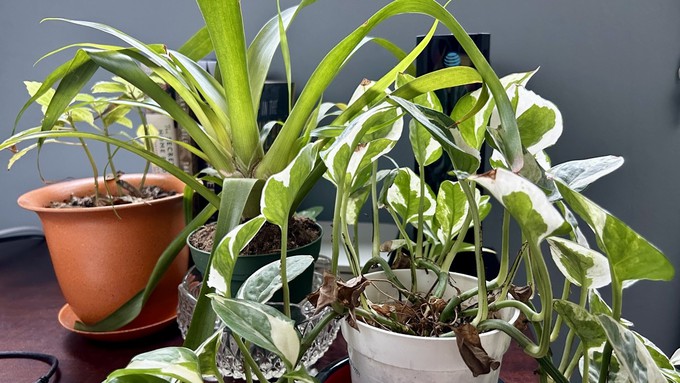
Time to show your indoor garden some love

These houseplants are thriving in the indirect light from a north-facing window. Kathy Morrison
It’s time to show some TLC to our indoor gardens. Why? Jan. 10 is National Houseplant Appreciation Day.
Our assortment of ferns, orchids and other tropical plants do more than decorate our rooms. They help keep us people healthier and happier.
The plants that make the best houseplants like the same conditions we do – temperatures in the 60s or 70s with bright in-direct light. They don’t ask much – weekly watering, a little fertilizer and an occasional dusting. In return, they offer a lot of positives.
Their foliage helps clean the air, filtering out pollutants and carbon dioxide while adding a little extra oxygen. In addition, houseplants contribute a little moisture and extra humidity to our indoor air, creating a more comfortable and cooler environment – for them and us.
Besides improving air quality, houseplants also have a therapeutic quality. We enjoy being around plants. They make us smile. They improve attitudes in both office and at home.
This day of recognition is credited to the Gardener’s Network (www.gardenersnet.com), which has been publishing an online gardening e-zine for 24 years. Nurseries and garden clubs spread recognition of this plant-centric commemoration.
Headquartered in Rochester, N.Y., the Gardener’s Network saw Houseplant Appreciation Day as a way snowbound gardeners could get their hands dirty in midwinter. Jan. 10 was chosen because it was after the holidays, likely after the exit of the Christmas tree.
Houseplants have never been more popular. With people stuck at home, the Covid-19 pandemic launched houseplant mania nationwide. Almost four years later, houseplant sales remain strong as people discovered they love their indoor jungles.
Low-maintenance plants are the best-sellers. That includes ZZ Plant (Zamioculcas zamiifolia), pothos and philodendron – especially variegated varieties. Also popular are indoor bloomers such as hoyas, moth and dendrobium orchids, anthuriums and dwarf bird of paradise.
Among the most efficient plants at cleaning air and improving air quality are peace lilies (Spathiphyllum).
How to celebrate Houseplant Appreciation Day?
* Start by checking soil moisture. Make sure your houseplants are well watered.
* Snip off dead foliage and show your plants some TLC.
* Dust the leaves; that helps the foliage function better.
* If possible, put your plants in the shower and give them a gentle indoor rain. That washes off dirt and grime that may have accumulated.
* Start some cuttings from your houseplants and share with friends.
* Get some more houseplants. The selection has never been better as more people discover the joy of indoor gardening. Find a new favorite or rediscover an old-time charmer.
For more advice on houseplants: https://www.gardenersnet.com/hplants/index.htm.
Comments
0 comments have been posted.Sacramento Digs Gardening to your inbox.
Food in My Back Yard Series
May 6: Maintain soil moisture with mulch for garden success
April 29: What's (already) wrong with my tomato plants?
April 22: Should you stock up on fertilizer? (Yes!)
April 15: Grow culinary herbs in containers
April 8: When to plant summer vegetables
April 1: Don't be fooled by these garden myths
March 25: Fertilizer tips: How to 'feed' your vegetables for healthy growth
March 18: Time to give vegetable seedlings some more space
March 11: Ways to win the fight against weeds
March 4: Potatoes from the garden
Feb. 25: Plant a fruit tree now -- for later
Feb. 18: How to squeeze more food into less space
Feb. 11: When to plant? Consider staggering your transplants
Feb. 4: Starting in seed starting
Sites We Like
Garden Checklist for week of May 11
Make the most of the lower temperatures early in the week. We’ll be back in the 80s by Thursday.
* Plant, plant, plant! It’s prime planting season in the Sacramento area. Time to set out those tomato transplants along with peppers and eggplants. Pinch off any flowers on new transplants to make them concentrate on establishing roots instead of setting premature fruit.
* Direct-seed melons, cucumbers, summer squash, corn, radishes, pumpkins and annual herbs such as basil.
* Harvest cabbage, lettuce, peas and green onions.
* In the flower garden, direct-seed sunflowers, cosmos, salvia, zinnias, marigolds, celosia and asters. (You also can transplant seedlings for many of the same flowers.)
* Plant dahlia tubers.
* Transplant petunias, marigolds and perennial flowers such as astilbe, columbine, coneflowers, coreopsis, dahlias, rudbeckia and verbena.
* Keep an eye out for slugs, snails, earwigs and aphids that want to dine on tender new growth.
* Feed summer bloomers with a balanced fertilizer.
* For continued bloom, cut off spent flowers on roses as well as other flowering plants.
* Add mulch to the garden to maintain moisture. Mulch also cuts down on weeds. But don’t let it mound around the stems or trunks of trees or shrubs. Leave about a 6-inch-to-1-foot circle to avoid crown rot or other problems.
* Remember to weed! Pull those nasties before they set seed.
* Water early in the day and keep seedlings evenly moist.